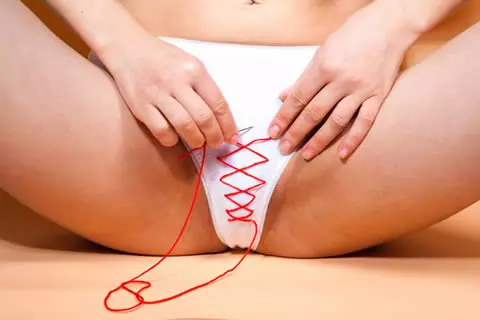Vaginismus Recovery is Possible
Is it painful to insert a tampon, get through a gynecological pelvic exam, or engage in intercourse? Have you always just thought maybe it’s just supposed to hurt and began to shy away from it all? You’re not alone. There are many women who have felt and thought the same things. What you are feeling is real and the culprit may be a condition called Vaginismus.
What is Vaginismus?
The definition of Vaginismus has been debated over the years and was first introduced into the Diagnostic and Statistical Manual of Mental Disorders (DSM), Third Edition in 1980. It was defined as a “recurrent or persistent involuntary spasm of the musculature of the outer third of the vagina that interferes with sexual intercourse”.1 And now in the DSM, Fifth Edition categorized as a disorder in which any form of vaginal penetration or insertion such as tampons, a digit, gynecological exams, vaginal dilators and intercourse is painful or impossible. Women have described it as “hitting a wall”. This disorder has been put under the umbrella of genito-pelvic pain/penetration disorder (GPPPD) in conjunction with dyspareunia (“recurrent or persistent genital pain associated with sexual intercourse”).2
There are two types of vaginismus, primary or secondary. Primary Vaginismus is when the individual has never experienced pain-free vaginal penetration and Secondary Vaginismus is when someone has had pain-free vaginal penetration in the past and is now experiencing subsequent painful penetration.2
Whether you may have primary or secondary vaginismus, there may be a psychological component manifested by fear and anxiety towards vaginal penetration and the feeling of “hitting a wall” is the physical component in which a spasm or overactive state of the pelvic floor muscles in response to stimuli is occurring. This muscle spasm is used to differentiate the diagnosis from other sexual pain disorders such as vulvodynia or vestibulodynia, although “the validity of the spasm-based criterion for vaginismus has never been evaluated”.3
Diagnosis of Vaginismus
Vaginismus recovery begins with a diagnosis with comprehensive medical and psychosexual questionnaires, digital examination, and pelvic exam. Before the diagnosis of vaginismus can be concluded, other possible sources of the pain (i.e. vulvodynia or vestibulodynia) must be ruled out by a pelvic exam. If you have any similar symptoms to the ones described below, make an appointment with your gynecologist and discuss your treatment options.
Symptoms and Associated Affects
The symptoms of vaginismus can vary from patient to patient, and often depend on variables such as the severity of the case, how long symptoms have been evident, and other individual physiological factors.
Some common symptoms associated with vaginismus include:
- Inability to use a tampon (this is usually discovered at a young age)
- Pain with the removal of a tampon
- Sensation of “hitting a wall” when attempting vaginal penetration
- No toleration of gynecological exams
- Painful intercourse
- Fear, anxiety, and pain of vaginal penetration
Etiology and Prevalence
The diagnosis is still fairly new to the evidence-based world, therefore the prevalence of vaginismus may be skewed. This may be due to definitional problems throughout the years and the lack of research data. In a 2018 Systematic Review and Meta-Analysis on the outcome of medical and psychosexual interventions for Vaginismus, they noted prevalence rates of:
- 30% in primary care settings
- 42% in specialized clinics for female sexual disorders
- 0.5-1% of community estimates4
We also have to take into consideration that some may NOT even report their symptoms due to common feelings of shame and embarrassment with sexuality and female genitalia. Unfortunately, living with these symptoms can have such a negative effect on an individual’s life and relationships, resulting in a poor quality of life.
Causes of vaginismus are still not clearly established; however, can be considered pathological and/or associated with psychological factors.
Suggested pathological causes include:
- Vaginal infections
- Trauma during childbirth
- Genital surgery
- Genital radiotherapy
- Vaginal lesions
- Congenital abnormalities
- Associated psychological factors include:
- Less positive or even negative attitudes towards sexuality
- Sexual abuse or trauma
- Relationship difficulties4
Living with Vaginismus
Millions of women worldwide have dealt with the symptoms of vaginismus at some point in their lives. Women experiencing various symptoms of vaginismus can feel:
- Shame
- Embarrassment
- Isolation
- Depression
- Fear
- Anxiety
- Silenced from failed treatments
- Failed relationships or marriages
- Lack of self-esteem
- Insecure attachment styles
- Hysterical traits
- Alexithymia (“inability to recognize or describe one’s own emotions”)4
As you can see, vaginismus can have a highly negative impact on one’s quality of life, and it’s important that we educate ourselves and our loved ones that may be suffering from this diagnosis, and let them know that there’s hope. There are treatments that have been shown to be effective and improve many individuals' quality of life.
Vaginismus Recovery and Treatments Used
Due to definitional challenges, unclear etiology, limited research, and disorder similarities (ex. dyspareunia) it is difficult to propose a good quality research on treatments for vaginismus. A lot of current treatments are based on expert opinions and clinical experience rather than evidence-based randomized clinical trials.4 However, within these clinical experiences clinicians have found successful outcomes for their patients.
To treat something that has both psychological and physical components, it’s ideal to have a multidisciplinary approach and a supportive team.
Some forms of treatments include:
- Vaginal dilators
- Physical Therapy with or without biofeedback
- Sex and relationship counseling
- Psychotherapy
- Cognitive behavioral therapy
- Lubricants
- Botox
One 2018 systematic review and meta-analysis found that approximately 80% of cases benefited from various treatments (behavioral sex therapy, CBT, pharmacological therapy, pelvic floor physical therapy and removal of hymenal remnants), with none superior than the other.
A clinical trial published in 2017 also found that 71% of the participants achieved pain-free intercourse within a mean of 5.1 weeks following a treatment involving botox, vaginal dilators and group counseling.
Although the mean time of effective treatment was recorded at 5 weeks, understand that everyone’s path and journey is unique to the individual. One person may take 5 weeks, where another can take 6 months to achieve pain-free intercourse. Everyone’s severity, lives, and environment are so different. Follow your path and enjoy this journey to self care and embrace the tremendous amount of knowledge you’ll gain towards a better quality of life.
Here at Femina Physical Therapy we having a caring and passionate team of physical therapists that can help you through this process. We work hand and hand with gynecologists and sex therapists to create a supportive health care team for you. You can make an appointment today at any of our locations to start the road to vaginismus recovery.
References:
American Psychiatric Association. Diagnostic and statistical manual of mental disorders. 3rd ed. Washington, DC: American Psychiatric Publishing; 1980
Pacik PT, Geletta S. Vaginismus Treatment: Clinical Trials Follow Up 241 Patients. Sex Med. 2017;5(2):e114-e123.
Reissing ED, Binik YM, Khalifé S, et al. Vaginal spasm, pain, and behavior: an empirical investigation of the diagnosis of vaginismus. Arch Sex Behav 2004;33:5-17.
Maseroli E, Scavello I, Rastrelli G, et al. 035 Outcome of Medical and Psychosexual Interventions for Vaginismus: A Systematic Review and Meta-analysis. The Journal of Sexual Medicine. 2018;15(6).
Lamont, J, Glob. libr. women's med., (ISSN: 1756-2228) 2011; DOI 10.3843/GLOWM.10430













